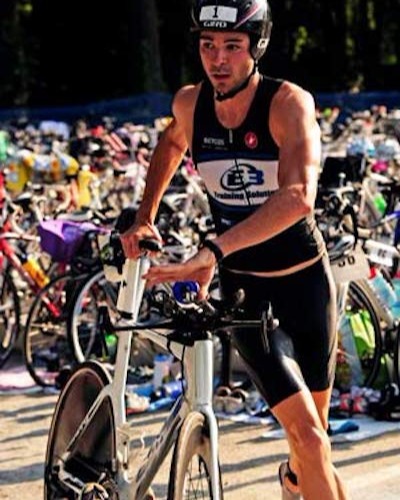MASTERING THE TRANSITION
Triathlete Tips
by Carolyn Pfalzgraf, pro triathlete
Landry's customer Carolyn Pfalzgraf competes professionally in triathlon. In these Landry's Triathlete Tips, she shares what she has learned.
"Everyone handles transition differently. As long as you are comfortable with your setup, that's all that matters. The name of the game is simplicity."
Want to know the best bang for your buck to improve in triathlon? It's not with the swim, bike, or run — it's the transition! With a little bit of practice and clever planning, you can save significant chunks of time and have a more pleasant race experience overall.
Since the transition takes up a very small percentage of the total finishing time, many triathletes tend to neglect it, choosing instead to take their time and recover between each segment. But smoothly going from swim to bike to run is key to a successful race for everyone, whether you are looking to beat your personal record or simply hoping to cross the finish line without any major hiccups.
Pre-race
Before the start of any race, you should scope out the transition area and become familiar with the layout. Know exactly where your spot will be. Look at all the signs, and be sure you know how to get in and out. Do a dress rehearsal in your head or even on the spot — and visualize 1) swim-in, 2) bike-out, 3) bike-in 4) run-out. It might seem obvious, but when you're an oxygen-deprived, mid-race mess, the transition area can quickly turn into a dizzying labyrinth. Literally going through the motions before the race will help you stay calm and keep your pace smooth as you move from swim to bike to run.
Setup
When you're preparing for your transition spot, first find your space on the racks and hang your bike by the nose of the seat. Make sure that your bike numbers are on the bike, your tires are pumped to the proper PSI, and your bike is stocked with fluids and nutrition. Most bike racks are laid out in an alternating pattern, so your bike will be facing the opposite way from those next to you. Next, set up a small mat or towel on the ground next to your bike — this is your spot. Place your biking gear toward the front of the mat (furthest from the rack) and your running gear toward the back of the mat (closest to the rack) since you'll need your biking gear first. Lay out your shoes with the tongues as wide open as they can be, with socks next to them and your other accessories like race belt, sunglasses, and visor.
Remember, everyone handles transition a little bit differently. As long as you are comfortable with your setup, that's all that matters. The name of the game is "simplicity". If the transition zone is too tight and crowded, it becomes impossible to navigate. Trust me, I've seen everything from buckets of water to huge duffel bags to multiple pairs of shoes to portable showers. Space is limited, less is more. Leave everything you don't need for the race in the car.
T1: Swim to bike
During the race, after you've conquered the swim, you'll stagger out of the water and enter the transition area. While you are walking/jogging to your spot, work on taking off the top half of your wetsuit. Only work it down to your waist until you get to your spot, and once there, work the legs of the suit off. Pro Tip 1: Applying Body Glide before you put your wetsuit on will make stripping it off much easier. Then put your helmet on. Pro Tip 2: Buckle your helmet strap as soon as you put it on to avoid a penalty. Give your feet a quick wipe to get the sand/dirt off, and if you're using socks now's the time to put 'em on. Strap/buckle/tie up your bike shoes – you are riding clipless, right? Put on your sunglasses, and you're off! Walk or run with your bike to the "Bike Out" exit and get on your bike as soon as you cross the mount line, following all instructions from the volunteers. Pro Tip 3: Before the race, make sure you're in an easy enough gear to start pedaling immediately – especially if the bike out is uphill!

T2: Bike to run
As you are finishing the biking leg, you will come to the dismount line where volunteers will tell you to get off your bike. Make sure you dismount after you cross this line, then head into the transition area toward your spot. DO NOT unbuckle your helmet until your bike is racked, as this will result in a penalty. Once your bike is away and your helmet is off, you can pop on your running shoes and race belt and head to the "Run Out" exit. Having your shoes tied beforehand can save time. Using elastic laces is one option, but pre-tied regular laces are also fine. Pro Tip 4: Putting some baby powder in the shoes can help them slide on and off easier.
Practice, practice, practice
If this seems like a lot to remember - it is! The only way to go through transitions smoothly is to practice them in a non-race setting. In the week leading up to the race, you won't be training as much, so you can use your time to practice transitions. Set up a transition area in your driveway or a parking lot and run through the motions until you feel comfortable — especially the dismount from the bike. You can also take small opportunities to practice bits and pieces of transition techniques when you can. For example, every time you swim in open water wearing your wetsuit, try to strip it off as fast as you can afterwards. Pretend that every open water swim exit is a race!
But always remember: Safety first! Keep calm and aware during the transition. If you crash your bike while mounting or dismounting, you could get seriously hurt and it certainly won't help your time either.
Bonus seconds
Once you've mastered the basics of transition and are beginning to compete for those coveted age-group awards, you can start thinking about the more difficult flying mount and dismount of your bicycle. Here's how it goes: First, as you approach the end of the biking stage, loosen your shoes when you're still several hundred yards from the dismount line (you should already know the course and have the spot picked out where you'll begin undoing your shoes). Once your shoes are loose, keep them clipped in, and pull your feet out so that you're riding on top of the shoes. As the line approaches, step over the top tube or swing your leg behind you (whatever comes naturally), scrub some speed with the brakes, and after you've crossed the line dismount into a full run! Immediately switch your grip on the bike from the handlebars to the seat — it's faster and easier to run pushing the bike by the seat. You'll be zooming into the transition area, barefoot and with your bike, without losing any momentum.
How NOT to transition
As shown in the video, flying mounts can be a little trickier. The first step to learning the flying mount is to be able to mount the bike while at a standstill by swinging one leg over the top tube and pushing off with the toe that's still on the ground. You'll get enough momentum to get the bike rolling, and you can mount the saddle, lock in your feet, and start pedaling from there. Once that becomes comfortable, you can scale up to walking with the bike, then eventually running and mounting. Soon enough you'll have your shoes pre-clipped into the pedals before the race starts, and you'll be able to run out of transition in your bare feet, hop onto the bike, and slide your feet in the shoes while riding! For this to work, your pedals will have to be at 9 and 3 o'clock, and I recommend using rubber bands to keep the shoes right side up. Once you start pedaling the rubber-bands will snap and off you go. This is something that requires considerable of practice, so do not try it for the first time in a race!
Key things to remember
- Be familiar with your plans for swim-in, bike-out, bike-in, and run-out before the race.
- Keep your spot simple with no extra gear.
- Make sure your bike is in an easy gear to start.
- Don't attempt flying mounts or dismounts in a race until you've mastered them.
Everything you need to know about triathlons
Learn more from Landry's about the sport of triathlon.
